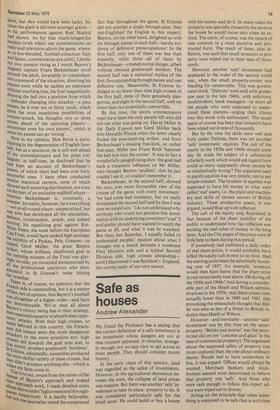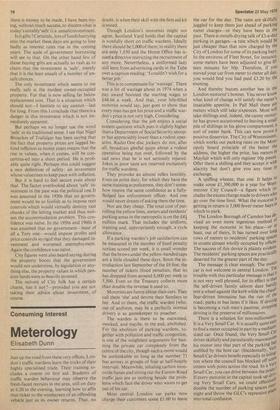Safe as houses
Andrew Alexander
My friend the Professor has a saying that the correct definition of a safe investment is an investment whose dangers are not at that moment apparent. It remains, strangely enough, not an easy view to get across to most people. They should consider recent history. In the early years of this century, land was regarded as the safest of investments. However, in the agricultural depression between the wars, the collapse of land prices was massive. But there was another 'safe' investment to take its place : property to let. It was considered particularly safe for the small saver. He could build or buy a house with his money and let it. In many cases the property was specially chosen by the saver as the house he would move into when he re tired. The catch, of course, was the return of rent controls in a most punitive and pro tracted form. The result of these, plus inflation, was such that small investors in property were wiped out in their tens of thousands.
However, another 'safe' investment had appeared in the wake of the second world war, when the small property-owner was heading for catastrophe. This was government stock. `Daltons' were sold with grotesque ease in the late 1940s, with solicitors, stockbrokers, bank managers—in short all the people who were supposed to understand these matters—urging their clients into this stock with enthusiasm. The result again of course has been that investors have been wiped out in tens of thousands.
But by the time the skids were well and truly under Daltons, there was yet another 'safe' investment : equities. The cult of the equity in the 1950s and 1960s should some day be made the subject of a substantial scholarly work which would ask (again) how could so many supposedly clever people be so emphatically wrong? The argument used to justify equities Was very simple, not to say simple-minded. The investor in equities was supposed to have his money in what were called 'real' assets, i.e. the plant and machinery and skills of chosen sectors of British industry. These productive assets, it was argued, would float up with inflation.
The cult of the equity only flourished in fact because of the sheer inability of the public to understand how fast inflation was eroding the real value of money in the long term. And the City pages of the press were of little help to them during this period.
If somebody had published a daily index of real share prices, it would probably have killed the equity cult in next to no time. Had the starting point been the admittedly booming year of 1937, for example, investors would then have learnt that the share price in real terms rarely rose above 100 during all the 1950s and 1960s! And during a considerable part of the Heath and Wilson administrations in the 1970s, real share prices were actually lower than in 1940 and 1941, this provoking the melancholy thought that Hitler was seen as less of a threat to British industry than Heath or Wilson.
However—and inevitably—another 'safe' investment was by this time on the scene : property. 'Bricks and mortar' was the resurrected old cry (or 'concrete and glass' in the case of commercial property). The argument about the supposed safety of property was more confused than the one about ordinary shares. People had to have somewhere to live, it was argued. Offices would always be wanted. Merchant bankers and stockbrokers seemed most determined to believe that property was 'safe'. And those who were rash enough to follow this expert advice were wiped out in droves.
Acting on the principle that when something is supposed to be safe (but is not) then there is money to be made, I have been trying, without much success, to discern what is today's notably'safe' (i.e. unsafe) investment.
Is it gilts ?Certainly, lots of funds hurrying into the market these days are going to lose badly as interest rates rise in the coming years. The scale of government borrowing will see to that. On the other hand few of those buying gilts are actually so rash as to claim that the investment is 'safe', merely that it is the least unsafe of a number of unsafe choices.
The only investment which seems to me really safe is the modest owner-occupied property. For that is now selling far below replacement cost. That is a situation which should not—I hesitate to say cannot—last for long. From this I conclude that there is a danger in this investment which is not immediately apparent.
But perhaps we no longer use the word 'safe' in its traditional sense. I see that Nigel Broackes of Trafalgar has been saying that the fact that property prices are lagged behind inflation in recent years means that the rise in values, when it comes, will be concertina-ed into a short period. He is probably quite right. Perhaps this could suggest a new definition of safety : an investment whose value rises to keep pace with inflation.
But it is hard to feel secure even about that. The factor overlooked about 'safe' investment in the past was the political one.It was assumed in the 1930s that no government would be so foolish as to impose rent controls which would virtually destroy vast chunks of the letting market and thus worsen the accommodation problem. This confidence was naïve. In the 1950s and 1960s it was assumed that no government—least of all a Tory one--would impose profits and price controls so rigid that they damaged investment and worsened unemployment. Again the confidence was naïve.
City figures were also heard saying during the property boom that the government would not undermine, by legislation or anything else, the property values in which pension funds were so heavily invested.
The naïveté of City folk has a certain charm, has it not ?—provided you are not taking their advice about investment, of course.



































 Previous page
Previous page